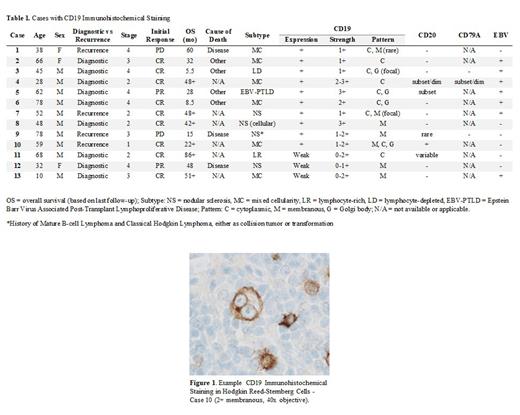Background: The neoplastic Hodgkin Reed-Sternberg (HRS) cells in Classical Hodgkin Lymphoma (CHL) are thought to lose their B-cell phenotype and lack expression of most B-cell markers. Improvements in antibodies and detection methods have revealed that a subset of CHL cases may express some B-cell markers, including CD19 and CD20, with currently unclear significance. Introduction of CD19-directed therapies has changed the landscape of salvage treatment in CD19 expressing Non-Hodgkin Lymphomas. As such, we sought to characterize CD19 expression in HRS cells and its clinical implications and potential utility as a therapeutic target.
Methods: We conducted an Institutional Review Board-approved retrospective review of records for CHL cases from 01/2015 to 07/2020 at a tertiary care center. 42 cases met the criteria and had sufficient tissue for analysis: 39 CHL, 2 CHL mixed with other B-cell lymphomas, and 1 Epstein Barr Virus Post-Transplant Lymphoproliferative Disease (EBV-PTLD)-CHL type. Cases were assessed for CD19 immunohistochemical (IHC) staining using the EP169 Rabbit Monoclonal Antibody. HRS cells were identified via morphology and characteristic immunoprofile, with all HRS cells expressing strong CD30 and dim PAX-5. CD19 staining intensity (0-3+) and pattern of expression (cytoplasmic, Golgi body, membranous) in HRS cells was independently evaluated by three hematopathologists. Based on their consensus, CD19 staining was categorized as negative, weak (variable across HRS cells), or positive. CD19 staining was compared with histologic subtype, other B-cell marker staining, EBV association (via EBER-ISH), and clinical data and outcomes, including, age, stage, treatment, response, overall survival, and demise.
Results: Histologically, cases were composed of the following subtypes: 26 nodular sclerosis, 8 mixed cellularity, 3 lymphocyte-rich, 1 lymphocyte-depleted, 2 other (EBV-PTLD and malignant B-cell lymphoma) and 2 unclassifiable (due to treatment effect and biopsy size). Nine of 42 cases (21%) were EBV-associated by EBER-ISH. CD19 staining of any kind in HRS cells was found in 13/42 cases (31%), with 10/42 (24%) demonstrating positive staining and 3/42 (7%) demonstrating weak staining. Staining intensity and pattern varied across positive cases (Table 1 and Figure 1). CD19 staining was seen in 4/26 nodular sclerosis (15%), 6/8 mixed cellularity (75%), 1/3 lymphocyte-rich (33%), and 1/1 lymphocyte-depleted (100%) cases. The strongest correlation with other markers was seen with EBV, with 7/9 (78%) EBV+ cases staining with CD19. Five cases with CD19 staining also demonstrated predominantly patchy/dim CD20 staining. The clinical characteristics of CHL cases with CD19 expression varied, with an age range of 10-78 years old and variable clinical stage at time of tissue sampling. Following initial treatment, 4/13 patients failed to achieve remissions after frontline chemotherapy (mostly ABVD), with 3 of these patients now deceased due to disease.
Conclusions: A significant subset of CHL cases demonstrate CD19 expression on HRS cells, and EBV-associated CHL has a high rate of CD19 expression, which may reflect its different underlying disease mechanism. Larger studies are necessary to characterize the staining pattern and intensity that may be most amenable to specific therapies and to better elucidate the prognostic implications of CD19 expression. Given the accessibility of CD19 IHC and the growing list of effective CD19-directed therapies, it is worthwhile assessing CD19 expression, particularly in EBV associated CHL, and further research into the utility of CD19 expression on HRS as a potential therapeutic target is warranted.
Disclosures
No relevant conflicts of interest to declare.


This feature is available to Subscribers Only
Sign In or Create an Account Close Modal